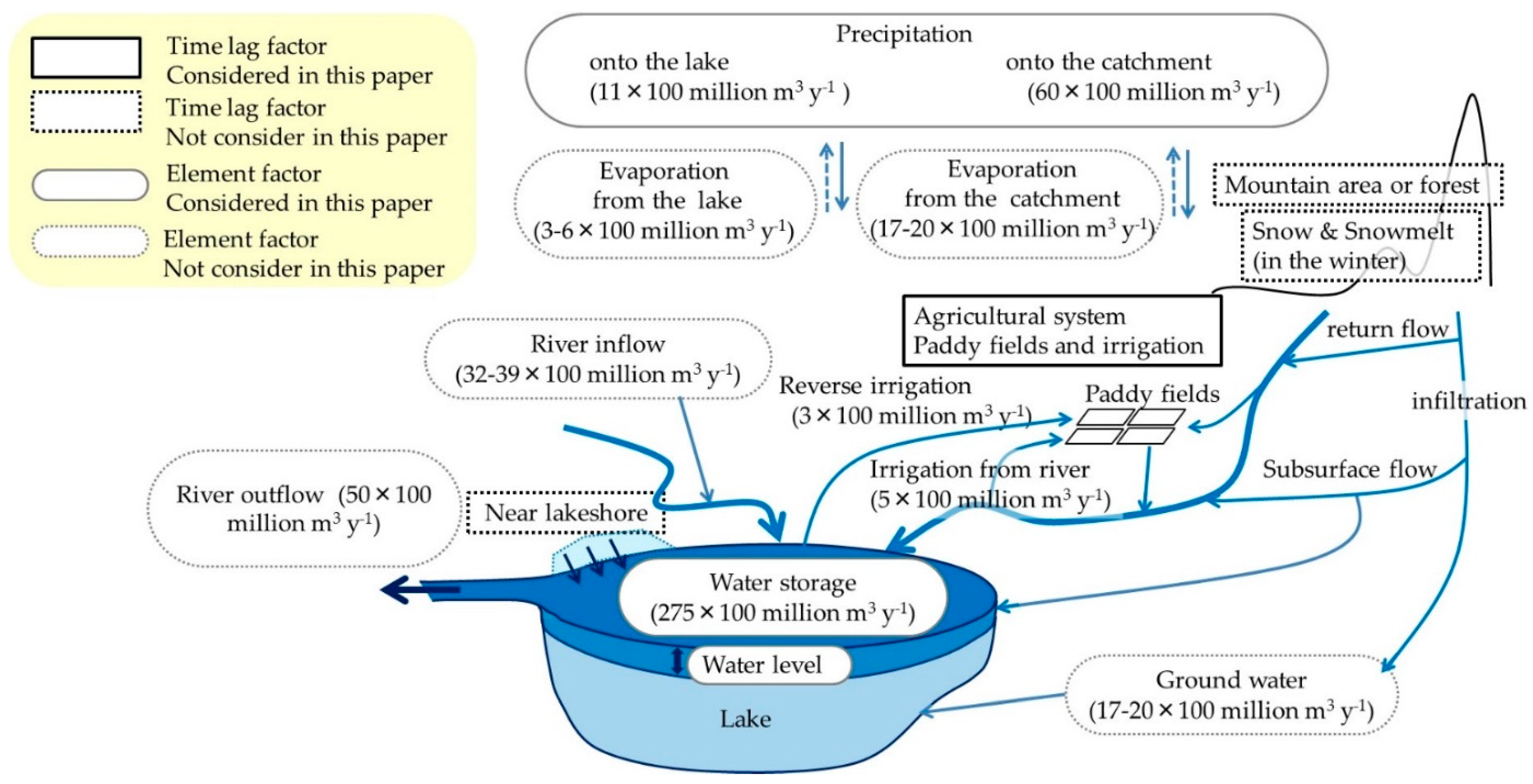An Estimation of Precipitation Retention Time Using Depth Metres in the Northern Basin of Lake Biwa
Abstract
1. Introduction
2. Materials and Methods
2.1. Study Site and Measurement of the Lake Water Level
2.2. Acquisition of Additional Data
2.3. Response Function
3. Results and Discussion
3.1. Delay Times Due to Direct Precipitation on the Lake
3.2. Inherent Oscillation of the Lake Internal Seiches
3.3. Paddy–Waterway System
- (i)
- Runoff process
- (ii)
- Delay times compared with river inflow (slow return flow; delay times are cited from Iwaki et al., 2020 [6])
- (iii)
- Comparison with seasonal changes
- (iv)
- Delay times did not change after a mega typhoon
3.4. Neglected Factors
4. Conclusions
Author Contributions
Funding
Institutional Review Board Statement
Informed Consent Statement
Data Availability Statement
Acknowledgments
Conflicts of Interest
Appendix A
| Duration | The Observation Data of Depth Metre around 5 m (m) | The Observation Data of Depth Metre around 10 m (m) | Six Points Average Precipitation (mm) | |||
|---|---|---|---|---|---|---|
| Average | S.D. | Average | S.D. | Accumulated | S.D. | |
| 21 August 2017–12 November 2017 | 5.89 | 0.64 | 10.66 | 0.62 | 7964.0 | 2.6 |
| 13 November 2017–8 February 2018 | 4.33 | 0.11 | 9.16 | 0.10 | 4174.5 | 0.8 |
| 16 March 2018–16 July 2018 | 5.40 | 0.22 | 10.22 | 0.23 | 11,578.0 | 2.5 |
| 20 July 2018–21 October 2018 | 4.30 | 0.50 | 9.12 | 0.46 | 7006.5 | 2.3 |
Appendix B
Appendix C
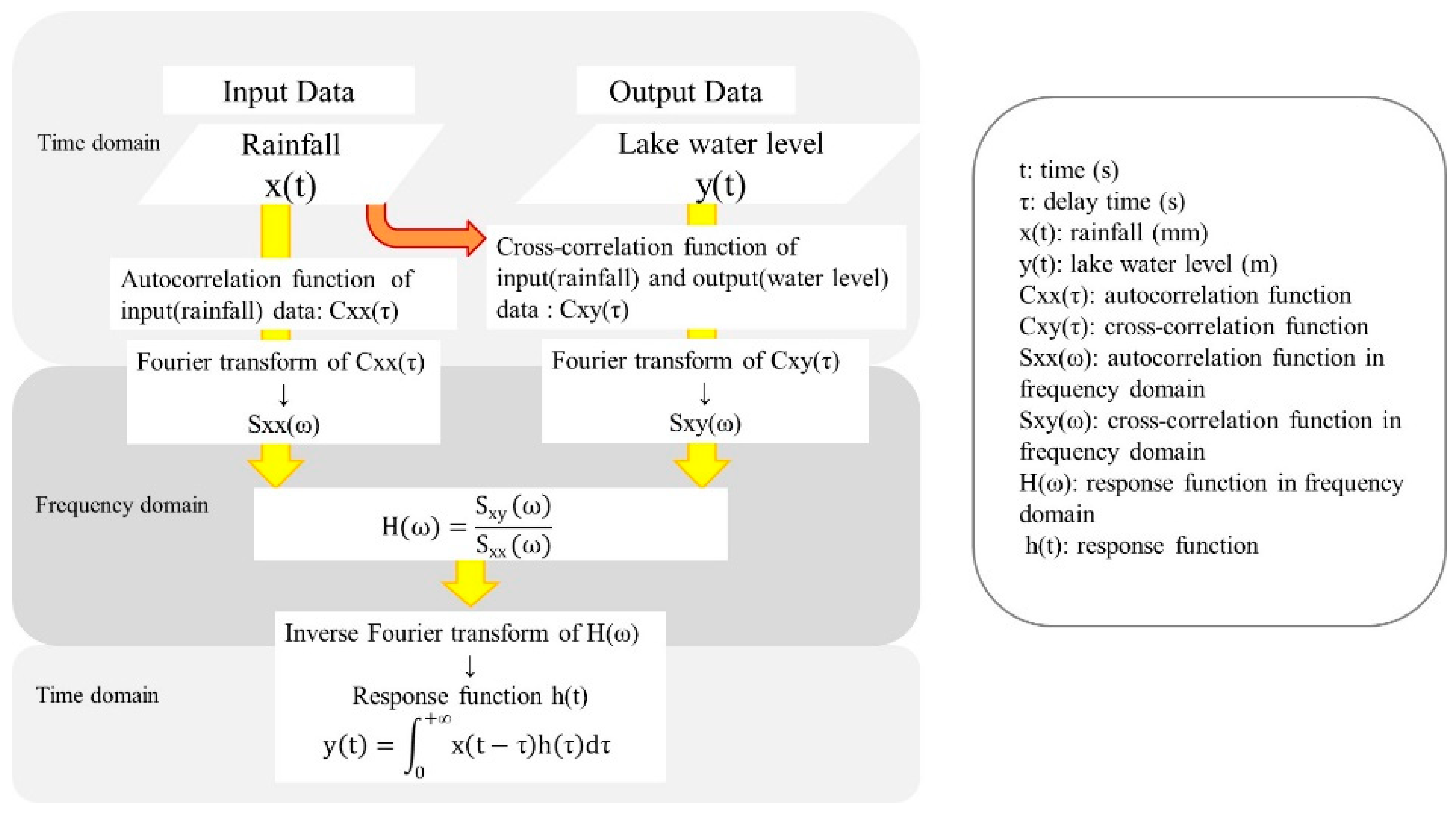
Appendix D
| (a) | |
| Two-sided t-tests with correspondence between two peaks of delay times | |
| n_4.2h = 47, m_7.7h = 71 | p < 0.005 |
| n_7.6h = 47, m_16h = 47 | p < 0.005 |
| n_16h = 145, m_24.5h = 145 | p < 0.005 |
| n_24.5h = 47, m_34h = 47 | p < 0.005 |
| (b) | |
| Two-sided t-tests with correspondence between two peaks of delay times | |
| n_55h = 51, m_71h = 51 | p < 0.005 |
| (c) | |
| Two-sided t-tests with correspondence between two peaks of delay times | |
| n_17.4d = 101, m_21.8d = 101 | p < 0.005 |
| n_17.2d = 101, m_21.8d = 101 | p < 0.005 |
Appendix E
References
- Oki, T.; Kanae, S. Global hydrological cycles and world water resources. Science 2006, 313, 1068–1072. [Google Scholar] [CrossRef] [PubMed]
- Ostrovsky, I.; Rimmer, A.; Yacobi, Z.Y.; Nishri, A.; Sukenik, A.; Hadas, O.; Zohary, T. Long-term changes in the Lake Kinneret ecosystem: The effects of climate change and anthropogenic factors. In Climatic Change and Global Warming of Inland Waters: Impacts and Mitigation for Ecosystems and SOCIETIES; Goldman, R.C., Kumagai, M.M., Robarts, D.R., Eds.; John Wiley & Sons: West Sussex, UK, 2013; Volume 16, pp. 271–291. [Google Scholar]
- Chen, S.C.; Liao, C.M.; Chio, C.P.; Chou, H.H.; You, S.H.; Cheng, Y.H. Lagged temperature effect with mosquito transmission potential explains dengue variability in southern Taiwan: Insights from a statistical analysis. Sci. Total Environ. 2010, 408, 4069–4075. [Google Scholar] [CrossRef] [PubMed]
- Hidaka, K. The Theory of Applied Integral Equation; Kawakita Press: Tokyo, Japan, 1943. (In Japanese) [Google Scholar]
- Yokoki, H.; Kuwahara, Y.; Hanawa, N.; Gunji, M.; Tomura, T.; Hirayama, A.; Miura, N. Estimation of the future flood and inundation risk on Japanese major river basins caused by climate change. Chikyu Kankyo Assoc. Int. Res. Initiat. Environ. Stud. 2009, 14, 237–246. (In Japanese) [Google Scholar] [CrossRef][Green Version]
- Iwaki, M.; Yamashiki, Y.; Muraoka, K.; Toda, T.; Jiao, C.; Kumagai, M. Effect of precipitation-influenced river influx on Lake Biwa water levels: Time scale analysis based on an impulse response function. Inland Waters 2020, 10, 283–294. [Google Scholar] [CrossRef]
- Delbart, C.; Valdés, D.; Barbecot, F.; Tognelli, A.; Couchoux, L. Spatial organization of the impulse response in a karst aquifer. J. Hydrol. 2016, 537, 18–26. [Google Scholar] [CrossRef]
- Hocking, M.; Kelly, B.F.J. Groundwater recharge and time lag measurement through Vertosols using impulse functions. J. Hydrol. 2016, 535, 22–35. [Google Scholar] [CrossRef]
- Tatas; Chu, H.J.; Burbey, J.T. Estimating future (next-month’s) spatial groundwater response from current regional pumping and precipitation rates. J. Hydrol. 2022, 604, 127160. [Google Scholar] [CrossRef]
- Burgan, H.I.; Aksoy, H. Daily flow duration curve model for ungauged intermittent subbasins of gauged rivers. J. Hydrol. 2022, 604, 127249. [Google Scholar] [CrossRef]
- Iwaki, M.; Yamashiki, Y.; Toda, T.; Jiao, C.; Kumagai, M. Estimation of the average retention time of precipitation at the surface of a catchment area for Lake Biwa. Water 2021, 13, 1711. [Google Scholar] [CrossRef]
- Zohary, T.; Ostrovsky, I. Ecological impacts of excessive water level fluctuations in stratified freshwater lakes. Inland Waters 2011, 1, 47–59. [Google Scholar] [CrossRef]
- Mizuno, T.; Otuska, T.; Ogawa, M.; Funao, T.; Kanao, S.; Maehata, M. Spawning migration triggers in round crucian carp Carassius auratus glandoculis and water level fluctuations in Lake Biwa. Jpn. J. Conserv. Ecol. 2010, 15, 211–217. (In Japanese) [Google Scholar]
- Sato, Y.; Nishino, M. Model analysis of the impact on spawning of cyprinid fishes by water level manipulation and prediction of the effect of measures. Wetl. Res. 2010, 1, 17–31. (In Japanese) [Google Scholar]
- Kikko, T.; Nemoto, M.; Ban, S.; Saegusa, J.; Sawada, N.; Ishizaki, D.; Nakahashi, T.; Teramoto, N.; Fujioka, Y. Efficient rearing of larvae and juveniles of Honmoroko Gnathopogon caerulescens in paddy fields. Aquac. Sci. 2013, 61, 303–309. [Google Scholar]
- Iwaki, M.; Kumagai, M.; Jao, C.; Nishi, K. Evaluation of river inflows during heavy precipitation based on water level changes in a large lake. Jpn. J. Limnol. 2014, 75, 87–98. (In Japanese) [Google Scholar] [CrossRef]
- Kizza, M.; Westerberg, I.; Rodhe, A.; Ntale, K.H. Estimating areal rainfall over Lake Victoria and its basin using ground-based and satellite data. J. Hydrol. 2012, 464–465, 401–411. [Google Scholar] [CrossRef]
- Rooney, G.G.; van Lipzig, N.; Thiery, W. Estimating the effect of rainfall on the surface temperature of a tropical lake. Hydrol. Earth Syst. Sci. 2018, 22, 6357–6369. [Google Scholar] [CrossRef]
- The Editorial Committee of Biwako Handbook (Eds.). Fluctuation of Lake Biwa. In Biwako Handbook; Shiga Prefecture: Shiga, Japan, 2010; p. 192. (In Japanese) [Google Scholar]
- Sakamoto, M.; Kumagai, M. Lakes and Drainage Basins in East Asia Monsoon Area; Nagoya University Press: Nagoya, Japan, 2006; p. 186. (In Japanese) [Google Scholar]
- Haga, H. Confirmation of surface area of the southern basin of Lake Biwa Japan. Jpn. J. Limnol. 2006, 67, 123–126. (In Japanese) [Google Scholar] [CrossRef]
- Hino, M. Spectrum Analysis; Asakura Press: Tokyo, Japan, 1977. (In Japanese) [Google Scholar]
- Kanari, S. Internal waves in Lake Biwa (I)-The responses of the thermocline to the wind action. Bull. Disaster Prev. Res. Inst. 1970, 19, 19–26. [Google Scholar]
- Kanari, S. The long-period internal waves in Lake Biwa. Limnol. Oceanogr. 1975, 20, 544–553. [Google Scholar] [CrossRef]
- Jiao, C.; Kumagai, M. Large amplitude nonlinear internal surge in Lake Biwa. Jpn. J. Limnol. 1995, 56, 279–289. [Google Scholar] [CrossRef]
- Nakada, S.; Haga, H.; Iwaki, M.; Mabuchi, K.; Takamura, N. High-resolution flow simulation in Typhoon 21, 2018: Massive loss of submerged macrophytes in Lake Biwa. Prog. Earth Planet. Sci. 2021, 8, 46. [Google Scholar] [CrossRef]
- Iwaki, M.; Takamura, N.; Nakada, S.; Oguma, H. Monitoring of lake environment using a fixed point and time-lapse camera—Case study of south basin of Lake Biwa. J. Remote Sens. Soc. Jpn. 2021, 41, 563–574. (In Japanese) [Google Scholar]
- Report of Kinki Regional Development Bureau, Infrastructure, Transport and Tourism, 2014, 2; 1–31. Available online: https://www.kkr.mlit.go.jp/river/iinkaikatsudou/kensyou/datatenkenkawaniu.html (accessed on 1 January 2022). (In Japanese).
- Kotoda, K. The estimation method of lake evaporation using climatological data. In Report of the Hydraulic Experiment University of Tsukuba Environmental Research Center Papers; University of Tsukuba: Tsukuba, Japan, 1977; pp. 53–65. (In Japanese) [Google Scholar]
- Ikebuchi, S.; Seki, M.; Ohtoh, A. Evaporation from Lake Biwa. J. Hydrol. 1988, 102, 427–449. [Google Scholar] [CrossRef]
- Fujino, Y. Water Budget. In An Introduction to Limnology of Lake Biwa; Mori, S., Ed.; Kyoto University: Kyoto, Japan, 1980; pp. 19–26. (In Japanese) [Google Scholar]
- Kawabata, H. Groundwater infiltration into the lake. Environ. Sci. Res. Rep. 1982, S704, 29–36. (In Japanese) [Google Scholar]
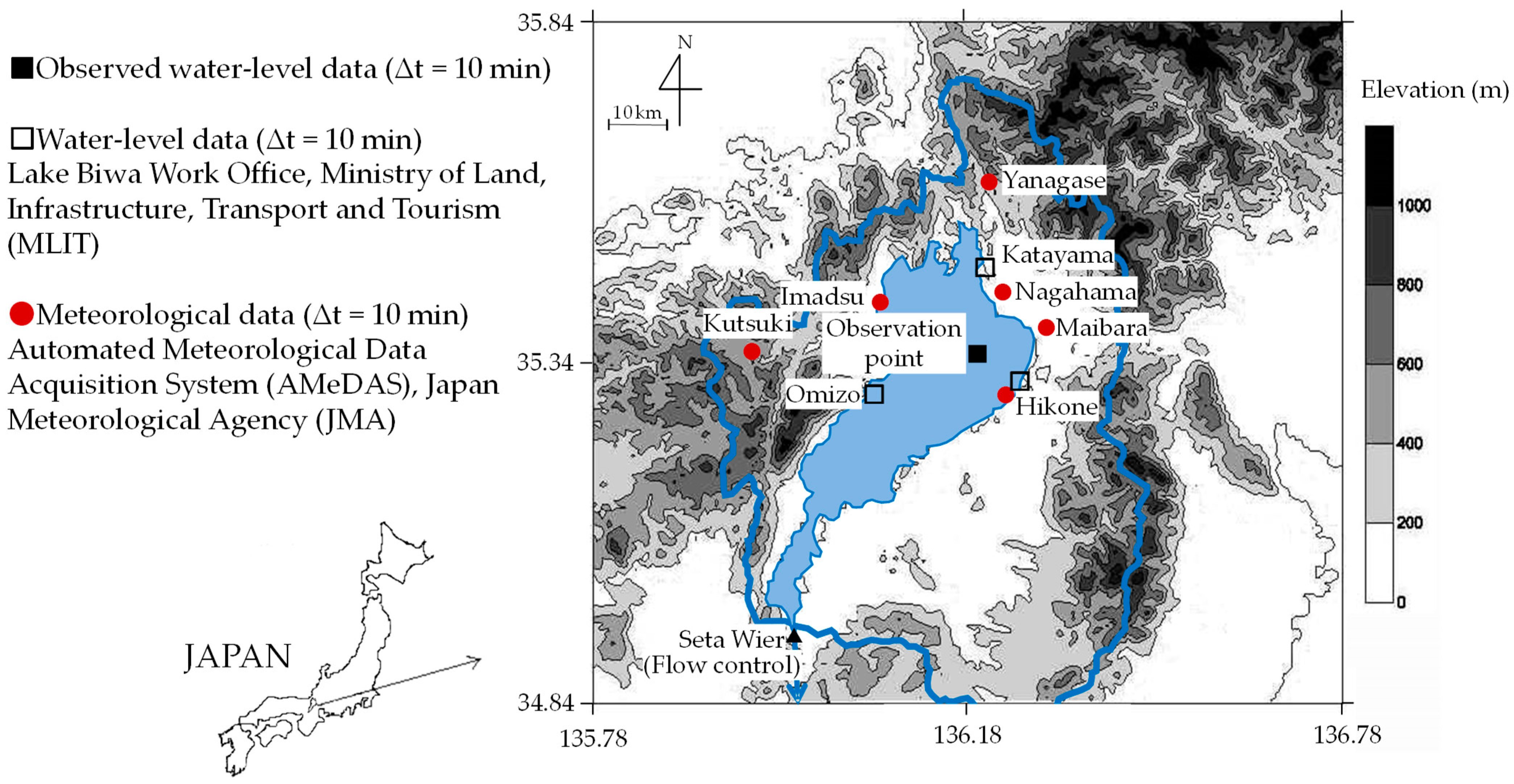
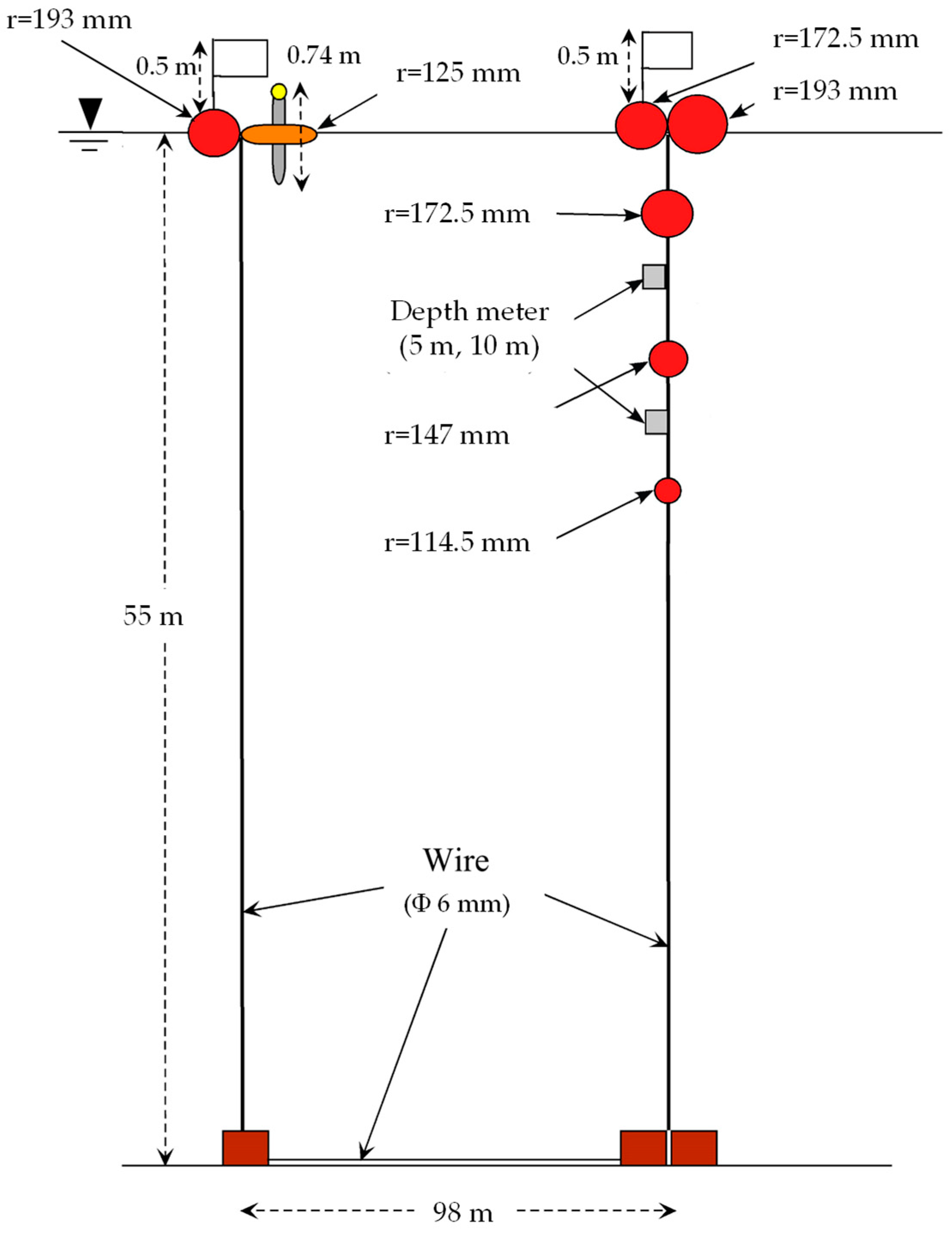
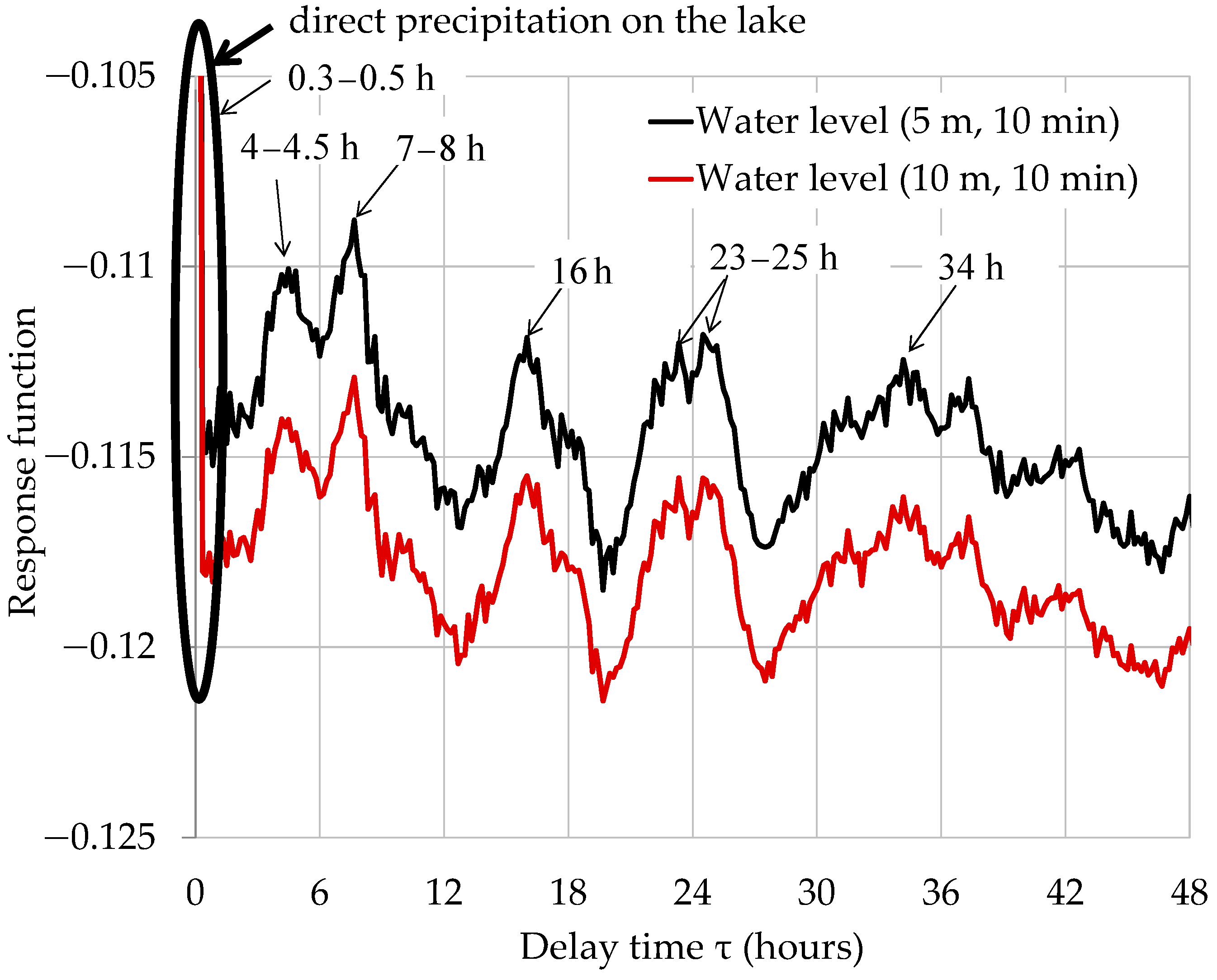
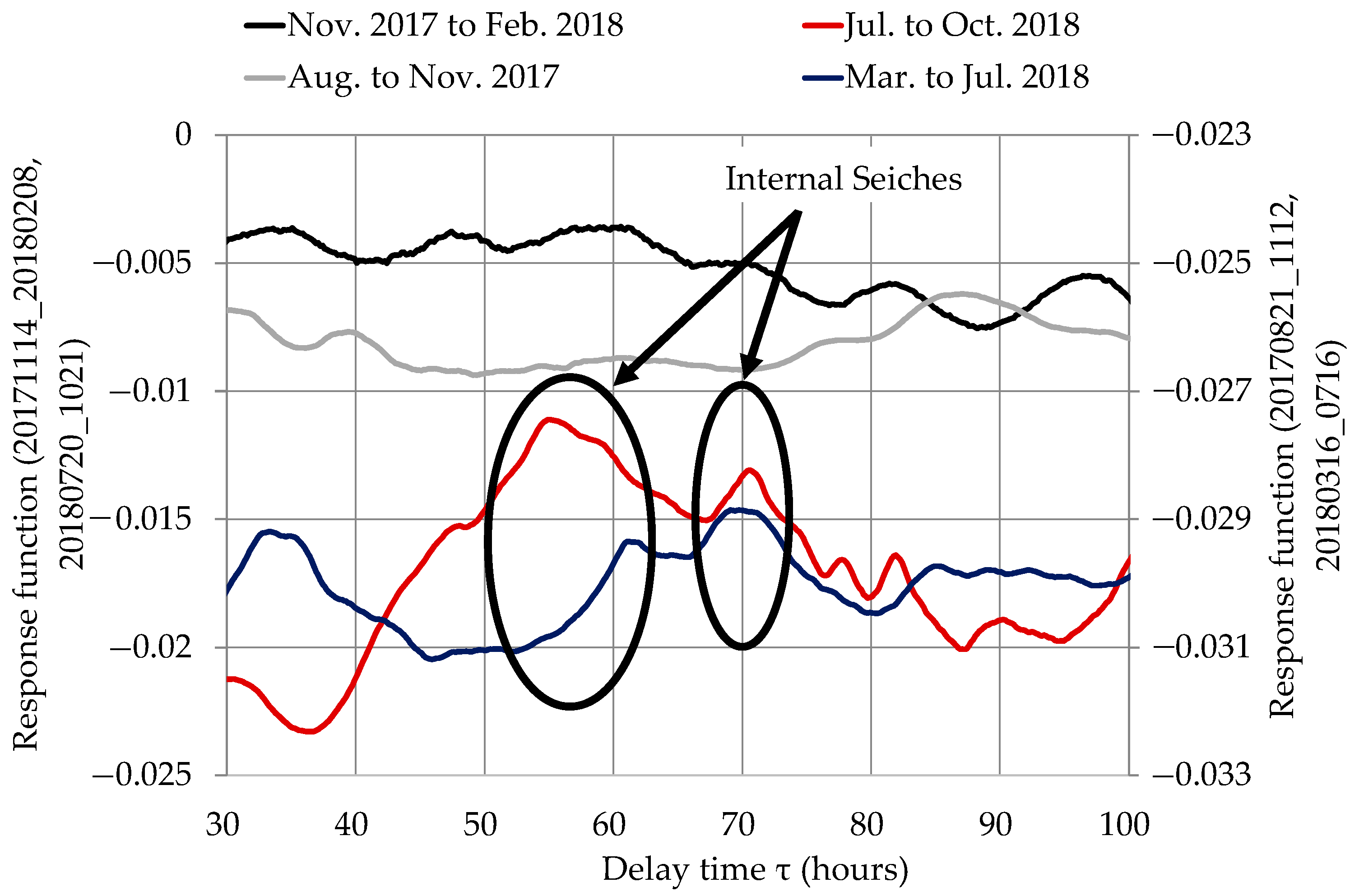
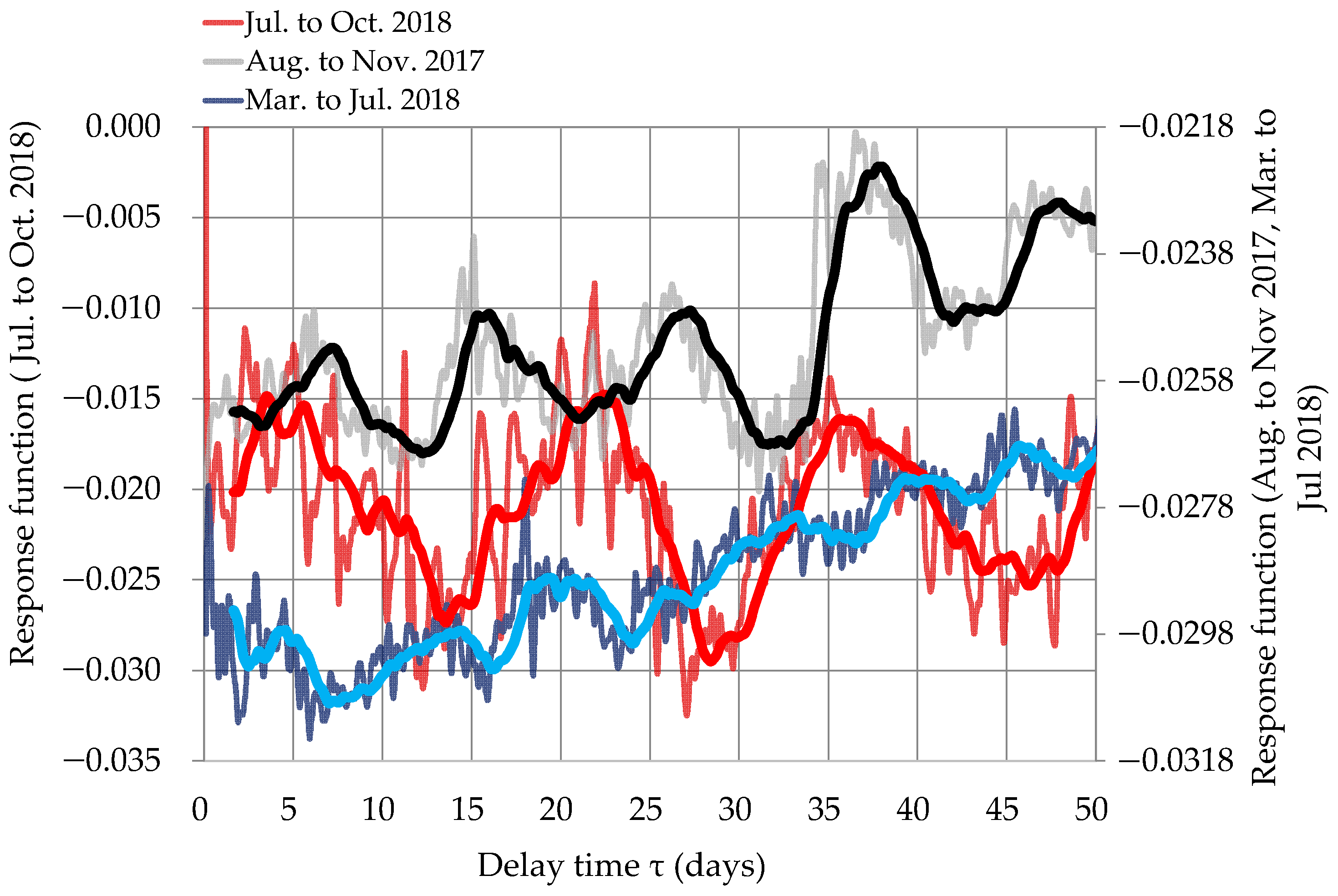
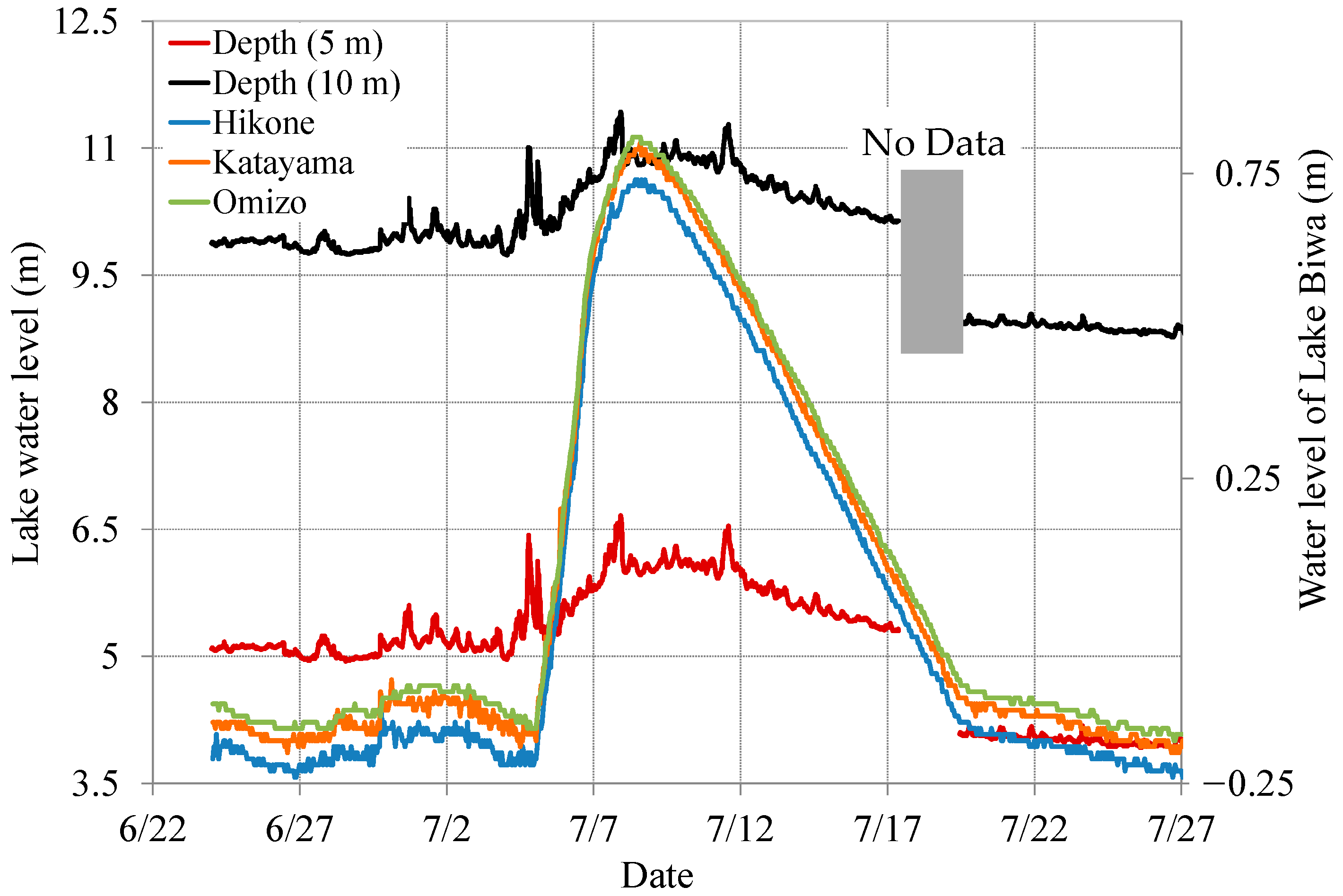
| Parameter | Time Interval | Data Provider | Website | Formats |
|---|---|---|---|---|
| Precipitation | 10 min | JMA | https://www.data.jma.go.jp/obd/stats/etrn/ (accessed on 1 January 2022) | .csv |
| Water level | 10 min | MLIT | http://www1.river.go.jp/cgi-bin/SiteInfo.exe?ID=306041286603060 (accessed on 1 January 2022) | .txt |
Publisher’s Note: MDPI stays neutral with regard to jurisdictional claims in published maps and institutional affiliations. |
© 2022 by the authors. Licensee MDPI, Basel, Switzerland. This article is an open access article distributed under the terms and conditions of the Creative Commons Attribution (CC BY) license (https://creativecommons.org/licenses/by/4.0/).
Share and Cite
Iwaki, M.; Hayakawa, K.; Goto, N. An Estimation of Precipitation Retention Time Using Depth Metres in the Northern Basin of Lake Biwa. Atmosphere 2022, 13, 724. https://doi.org/10.3390/atmos13050724
Iwaki M, Hayakawa K, Goto N. An Estimation of Precipitation Retention Time Using Depth Metres in the Northern Basin of Lake Biwa. Atmosphere. 2022; 13(5):724. https://doi.org/10.3390/atmos13050724
Chicago/Turabian StyleIwaki, Maho, Kazuhide Hayakawa, and Naoshige Goto. 2022. "An Estimation of Precipitation Retention Time Using Depth Metres in the Northern Basin of Lake Biwa" Atmosphere 13, no. 5: 724. https://doi.org/10.3390/atmos13050724
APA StyleIwaki, M., Hayakawa, K., & Goto, N. (2022). An Estimation of Precipitation Retention Time Using Depth Metres in the Northern Basin of Lake Biwa. Atmosphere, 13(5), 724. https://doi.org/10.3390/atmos13050724






